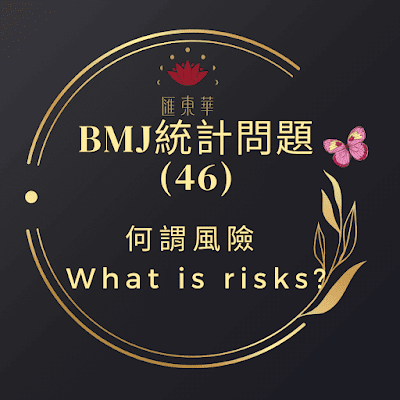BMJ小小統計問題(46):何謂風險 (What is risks?)
前言:
我只問你們一句:何謂風險?知道的舉手。之前學過什麼population at risk、relative risk、risk factors,還有日常生活也常看到風險,不過,到底什麼是風險呢?怎麼解釋結果所得的風險呢?按照你的直覺解釋,錯誤的可能性很高。不信嗎?這篇文章會有解答。Hope u enjoy it.😊
題目:
對於慢性阻塞性肺病急性惡化的患者,到院前的滴定氧與高流量氧氣的標準治療方案進行比較。採用分組、隨機對照、平行組試驗。總共納入405名被診斷為慢性阻塞性肺疾病急性惡化的患者,這些患者已經接受了醫護人員的治療,並被送往醫院。226例患者隨機接受高流量氧治療,179例接受滴定氧治療。主要結局衡量指標是死亡率,包括院前或院內死亡率[1]。
隨機分配滴定氧治療的患者的死亡風險低於隨機分配高流量氧治療的患者(7例死亡(3.9%) vs 21例死亡(9.3%))。研究人員得出結論,在慢性阻塞性肺疾病急性惡化期,與高流量氧治療相比,滴定氧治療顯著降低了死亡率(相對風險0.42 (95%信賴區間:0.2 - 0.89; P = 0.02)。
下列敘述何者正確?
a)死亡風險是死亡的機率。
b)滴定氧治療組每個患者的死亡風險為0.039。
c)滴定氧治療組的死亡風險相對於高流量氧治療組降低58%。
答案:
a,c正確,b錯誤
詳細說明:
本研究比較入院前滴定氧與高流量氧的標準治療程序對慢性阻塞性肺病急性惡化期病人死亡率的影響。使用滴定氧的死亡率低於使用高流量氧的死亡率(7例死亡(3.9%)對21例死亡(9.3%))。死亡風險(院前或院內)等於死亡機率(a正確)。機率為一個從0到1的數值尺度,包括及描述一個事件發生的頻率。在上述例子中,事件為死亡,死亡機率為試驗期內死亡的患者比例。高流量氧治療組226例患者中有21例死亡,死亡機率為0.093。在滴定氧組179例患者中有7例死亡,死亡機率為0.039。這種機率的推導被稱為頻率學派法(frequentist approach),因為它基於樣本中觀察到的頻率。
“風險”(risk)通常帶有負面含義,作為動詞時,意味著某人處於危險之中。然而,在統計學中,風險是機率的另一種說法,並不一定意味著會發生有害的事情。然而,因為醫療保健常關注的是預防不良後果,風險可能已經成為機率的的替代詞。從本質上講,機率衡量的是事件發生的不確定性。事件可能是有害的,如上述例子中的死亡。然而,事件也有可能是正面的結果,如懷孕。
滴定氧處理的死亡機率為0.039,高流量氧處理的死亡機率為0.093。根據定義,這些機率適用於治療組別,而非組內的單個患者。因此,在滴定氧治療組的患者並不是每個都有0.039的死亡風險(b錯誤);而是,該治療組的死亡風險為0.039。
與高流量氧處理相比,滴定氧處理的相對死亡風險(RR)為0.42。此為母群體參數的樣本估計值。相對風險(相對危險性)[2]意指暴露於滴定氧對於高氧流量治療組的死亡風險的影響。因此,與高流量氧相比,使用滴定氧的死亡風險降低了58% (c正確)。這種風險的降低適用於滴定氧治療組,而不是一個接受治療的患者。
如果患者採用滴定氧治療而不是高流量氧,會降低死亡風險。樣本結果為治療方式對母群體影響的估計,然而,將結果應用於單個患者可能是困難的。若病人有共病,可能會增加死亡的可能性。用滴定氧治療不能保證存活;上述研究僅表明,與高流量氧治療相比,該治療與死亡頻率的降低有關。將這一概念傳達給患者和臨床醫生可能有困難。此外,尚不清楚的是,使用高流量氧氣治療而死亡的患者是否會在使用滴定氧治療後存活,或那些使用滴定氧治療後存活的患者是否會在使用高流量氧氣治療後死亡。
References:
[1] Austin MA, Wills KE, Blizzard L, Walters EH, Wood-Baker R. Effect of high flow oxygen on mortality in chronic obstructive pulmonary disease patients in pre-hospital setting: randomised controlled trial. BMJ 2010;341:c5462.
[2] Sedgwick P, Marston L. Relative risks. BMJ 2010;341:c3983.
#BMJ
#醫學統計
#Risks
#Relative risk
原文題目:
Titrated oxygen was compared with the standard treatment of high flow oxygen for patients with acute exacerbation of chronic obstructive pulmonary disease in the pre-hospital setting. A cluster, randomised controlled, parallel group trial was performed. In total, 405 patients with a presumed acute exacerbation of chronic obstructive pulmonary disease that had been treated by paramedics and who had been transported and admitted to hospital were included. A total of 226 patients were randomised to high flow oxygen and 179 to titrated oxygen. The main outcome measure was mortality, either pre-hospital or in-hospital mortality.[1]
The risk of mortality in patients randomised to titrated oxygen treatment was less than that in the patients randomised to high flow oxygen (seven deaths (3.9% of patients) versus 21 deaths (9.3%)). The researchers concluded that titrated oxygen treatment significantly reduced mortality in comparison with high flow oxygen in acute exacerbations of chronic obstructive pulmonary disease (relative risk 0.42 (95% confidence interval 0.2 to 0.89; P=0.02)).
Which of the following statements, if any, are true?
a) The risk of mortality is the probability of death.
b) Each patient in the titrated oxygen treatment group had a risk of death of 0.039.
c) The risk of death in the titrated oxygen treatment group was reduced by 58% relative to the high flow oxygen treatment group.
Answers
Statements a and c are true, while b is false
https://www.bmj.com/content/345/bmj.e7036
Cite this as: BMJ 2012;345:e7036





沒有留言:
張貼留言